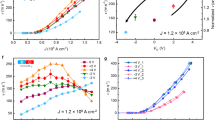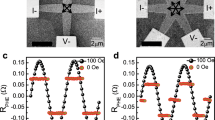Abstract
Antiferromagnets have several favourable properties as active elements in spintronic devices, including ultra-fast dynamics, zero stray fields and insensitivity to external magnetic fields1. Tetragonal CuMnAs is a testbed system in which the antiferromagnetic order parameter can be switched reversibly at ambient conditions using electrical currents2. In previous experiments, orthogonal in-plane current pulses were used to induce 90° rotations of antiferromagnetic domains and demonstrate the operation of all-electrical memory bits in a multi-terminal geometry3. Here, we demonstrate that antiferromagnetic domain walls can be manipulated to realize stable and reproducible domain changes using only two electrical contacts. This is achieved by using the polarity of the current to switch the sign of the current-induced effective field acting on the antiferromagnetic sublattices. The resulting reversible domain and domain wall reconfigurations are imaged using X-ray magnetic linear dichroism microscopy, and can also be detected electrically. Switching by domain-wall motion can occur at much lower current densities than those needed for coherent domain switching.
This is a preview of subscription content, access via your institution
Access options
Access Nature and 54 other Nature Portfolio journals
Get Nature+, our best-value online-access subscription
$29.99 / 30 days
cancel any time
Subscribe to this journal
Receive 12 print issues and online access
$259.00 per year
only $21.58 per issue
Buy this article
- Purchase on Springer Link
- Instant access to full article PDF
Prices may be subject to local taxes which are calculated during checkout




Similar content being viewed by others
References
Jungwirth, T., Marti, X., Wadley, P. & Wunderlich, J. Antiferromagnetic spintronics. Nat. Nanotech. 11, 231–241 (2016).
Wadley, P. et al. Electrical switching of an antiferromagnet. Science 351, 587–590 (2016).
Olejník, K. et al. Antiferromagnetic CuMnAs multi-level memory cell with microelectronic compatibility. Nat. Commun. 8, 15434 (2017).
Parkin, S. S. P., Hayashi, M. & Thomas, L. Magnetic domain-wall racetrack memory. Science 320, 190–194 (2008).
Zhang, X., Liu, Q., Luo, J.-W., Freeman, A. J. & Zunger, A. Hidden spin polarization in inversion-symmetric bulk crystals. Nat. Phys. 10, 387–393 (2014).
Železný, J. et al. Relativistic Néel-order fields induced by electrical current in antiferromagnets. Phys. Rev. Lett. 113, 157201 (2014).
Wadley, P. et al. Tetragonal phase of epitaxial room-temperature antiferromagnet CuMnAs. Nat. Commun. 4, 2322 (2013).
Grzybowski, M. J. et al. Imaging current-induced switching of antiferromagnetic domains in CuMnAs. Phys. Rev. Lett. 118, 057701 (2017).
Bodnar, S. Yu. et al. Writing and reading antiferromagnetic Mn2Au: Néel spin–orbit torques and large anisotropic magnetoresistance.Nat. Commun. 9, 348 (2018).
Meinert, M., Graulich, D. & Matalla-Wagner, T. Key role of thermal activation in the electrical switching of antiferromagnetic Mn2Au. Preprint at http://lanl.arxiv.org/abs/1706.06983 (2017).
Olejnik, K. et al. THz electrical writing speed in an antiferromagnetic memory. Science Advances (in the press); https://arxiv.org/abs/1711.08444.
Gomonay, O., Jungwirth, T. & Sinova, J. High antiferromagnetic domain wall velocity induced by Néel spin-orbit torques. Phys. Rev. Lett. 117, 017202 (2016).
Roy, P. E., Otxoa, R. M. & Wunderlich, J. Robust picosecond writing of a layered antiferromagnet by staggered spin-orbit fields. Phys. Rev. B 94, 014439 (2016).
Wadley, P. et al. Antiferromagnetic structure in tetragonal CuMnAs thin films. Sci. Rep. 5, 17079 (2015).
Shiino, T. et al Antiferromagnetic domain wall motion driven by spin–orbit torques. Phys. Rev. Lett. 117, 087203 (2016).
Selzer, S., Atxitia, U., Ritzmann, U., Hinzke, D. & Nowak, U. Inertia-free thermally driven domain-wall motion in antiferromagnets. Phys. Rev. Lett. 117, 107201 (2016).
van der Laan, G., Telling, N. D., Potenza, A., Dhesi, S. S. & Arenholz, E. Anisotropic X-ray magnetic linear dichroism and spectromicroscopy of interfacial Co/NiO(001). Phys. Rev. B 83, 064409 (2011).
Wadley, P. et al. Control of antiferromagnetic spin axis orientation in bilayer Fe/CuMnAs films. Sci. Rep. 7, 11147 (2017).
Acknowledgements
We thank the Diamond Light Source for the allocation of beam time under Proposal no. SI16376-1. This work was supported by the Engineering and Physical Sciences Research Council (grant number EP/P019749/1), National Science Centre, Poland (grant 2016/21/N/ST3/03380), the Ministry of Education of the Czech Republic Grants no. LM2015087 and no. LNSM-LNSpin, the Czech National Science Foundation Grant no. 14-37427, the EU FET Open RIA Grant no. 766566 and the ERC Synergy Grant no. 610115. P.W. acknowledges support from the Royal Society through a University Research Fellowship.
Author information
Authors and Affiliations
Contributions
P.W., K.W.E., B.L.G., J.W. and T.J. were responsible for the experimental concept and design. K.W.E. and P.W provided experimental coordination of the project. R.P.C. and V.N. performed the material growth. J.S.C., P.W. and C.A. provided device design and photolithography of devices. S.R., M.J.G., K.W.E, P.W., F.M. and S.S.D. performed XMLD-PEEM measurements and analysis of results. S.R. performed electrical transport measurements and analysis. M.W. supplied magnetometry measurements of the materials. All authors contributed to the interpretation of the results and writing of the manuscript.
Corresponding author
Ethics declarations
Competing interests
The authors declare no competing interests.
Additional information
Publisher’s note: Springer Nature remains neutral with regard to jurisdictional claims in published maps and institutional affiliations.
Supplementary information
Supplementary Information
Supplementary Figures 1–4; Supplementary Text; Supplementary References.
Rights and permissions
About this article
Cite this article
Wadley, P., Reimers, S., Grzybowski, M.J. et al. Current polarity-dependent manipulation of antiferromagnetic domains. Nature Nanotech 13, 362–365 (2018). https://doi.org/10.1038/s41565-018-0079-1
Received:
Accepted:
Published:
Issue Date:
DOI: https://doi.org/10.1038/s41565-018-0079-1
This article is cited by
-
Coherent antiferromagnetic spintronics
Nature Materials (2023)
-
Current-driven writing process in antiferromagnetic Mn2Au for memory applications
Nature Communications (2023)
-
Terahertz Néel spin-orbit torques drive nonlinear magnon dynamics in antiferromagnetic Mn2Au
Nature Communications (2023)
-
Antiferromagnetic half-skyrmions electrically generated and controlled at room temperature
Nature Nanotechnology (2023)
-
Anomalous Hall antiferromagnets
Nature Reviews Materials (2022)



